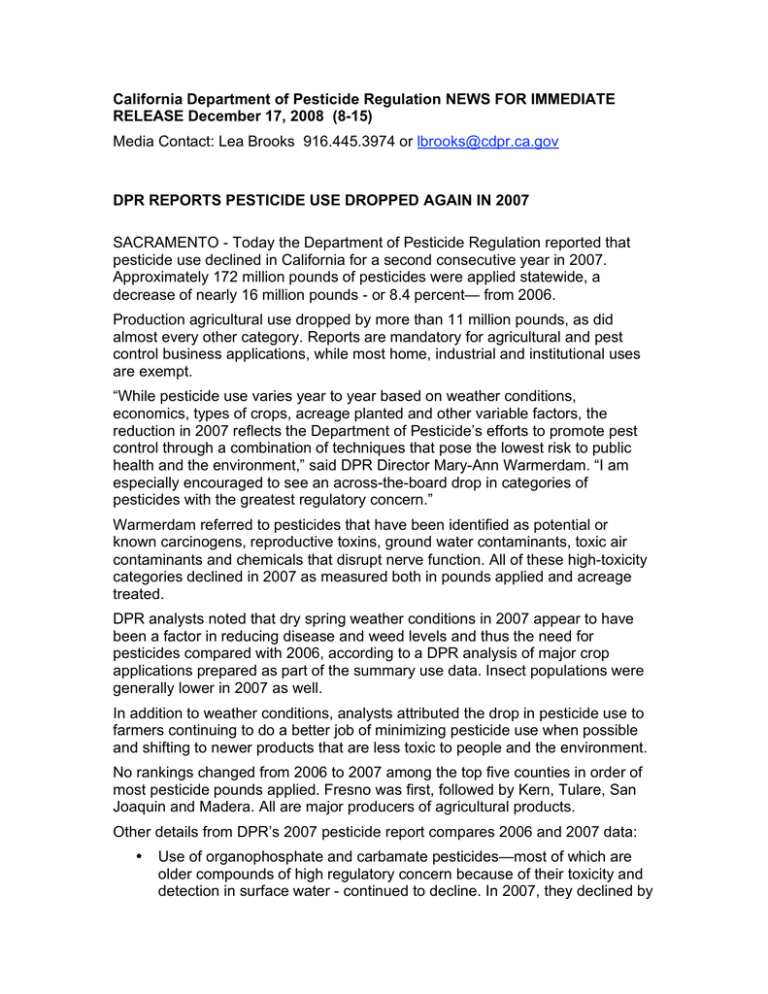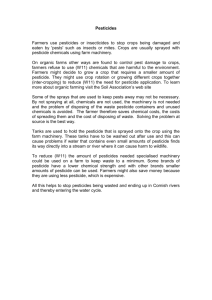California Department of Pesticide Regulation NEWS FOR IMMEDIATE
advertisement

California Department of Pesticide Regulation NEWS FOR IMMEDIATE RELEASE December 17, 2008 (8-15) Media Contact: Lea Brooks 916.445.3974 or lbrooks@cdpr.ca.gov DPR REPORTS PESTICIDE USE DROPPED AGAIN IN 2007 SACRAMENTO - Today the Department of Pesticide Regulation reported that pesticide use declined in California for a second consecutive year in 2007. Approximately 172 million pounds of pesticides were applied statewide, a decrease of nearly 16 million pounds - or 8.4 percent— from 2006. Production agricultural use dropped by more than 11 million pounds, as did almost every other category. Reports are mandatory for agricultural and pest control business applications, while most home, industrial and institutional uses are exempt. “While pesticide use varies year to year based on weather conditions, economics, types of crops, acreage planted and other variable factors, the reduction in 2007 reflects the Department of Pesticide’s efforts to promote pest control through a combination of techniques that pose the lowest risk to public health and the environment,” said DPR Director Mary-Ann Warmerdam. “I am especially encouraged to see an across-the-board drop in categories of pesticides with the greatest regulatory concern.” Warmerdam referred to pesticides that have been identified as potential or known carcinogens, reproductive toxins, ground water contaminants, toxic air contaminants and chemicals that disrupt nerve function. All of these high-toxicity categories declined in 2007 as measured both in pounds applied and acreage treated. DPR analysts noted that dry spring weather conditions in 2007 appear to have been a factor in reducing disease and weed levels and thus the need for pesticides compared with 2006, according to a DPR analysis of major crop applications prepared as part of the summary use data. Insect populations were generally lower in 2007 as well. In addition to weather conditions, analysts attributed the drop in pesticide use to farmers continuing to do a better job of minimizing pesticide use when possible and shifting to newer products that are less toxic to people and the environment. No rankings changed from 2006 to 2007 among the top five counties in order of most pesticide pounds applied. Fresno was first, followed by Kern, Tulare, San Joaquin and Madera. All are major producers of agricultural products. Other details from DPR’s 2007 pesticide report compares 2006 and 2007 data: • Use of organophosphate and carbamate pesticides—most of which are older compounds of high regulatory concern because of their toxicity and detection in surface water - continued to decline. In 2007, they declined by 1.1 million pounds and 756,000 acres treated, or 16 percent and 13 percent, respectively. For example, use of diazinonp, an organophosphate insecticide that is mostly used on lettuce, almonds, broccoli and prunes, has been decreasing for years. • Use of chemicals classified as reproductive toxins declined by 1.9 million pounds and 130,000 acres treated, or 10 percent and 7 percent, respectively. These chemicals are used on a variety crops. • Use of chemicals classified as probable or known carcinogens declined by 2.7 million pounds and 547,000 acres treated, or 10 percent and 15 percent respectively. These chemicals are used on a variety crops. • Use of chemicals classified as toxic air contaminants declined by 2.5 million pounds and 452,000 acres treated, or 6.3 percent and 12 percent, respectively. These chemicals are used on a variety crops. • Use of chemicals classified as ground water contaminants declined by 303,000 pounds and 275,000 acres treated, or 16 percent and 18 percent, respectively. These chemicals ar e used on a variety crops. • Use of fumigants decreased by 294,000 pounds, or .8 percent, but acres treated increased by 1,235 acres, or .3 percent. Fumigants are gaseous pesticides that farmers use before planting to control disease, weeds and pests in the soil and mostly are used on strawberry, carrot and processing tomato fields and for structural pest control. • Use of oil pesticides declined by 4.3 million pounds, or 13 percent, but increased by 118,000 acres treated, or 3.7 percent. Most oils serve as an alternative to high-toxicity pesticides. DPR has the most extensive pesticide use reporting system in the United States and supports one of the most comprehensive pesticide regulatory programs in the world. Use data support a variety of regulatory efforts, including compliance efforts for clean air and water laws, estimating dietary risks, protecting workers in the field, preserving endangered species, assisting product registration and review and helping local pesticide law enforcement. One of six departments and boards within the California Environmental Protection Agency, DPR regulates the sale and use of pesticides to protect people and the environment.








